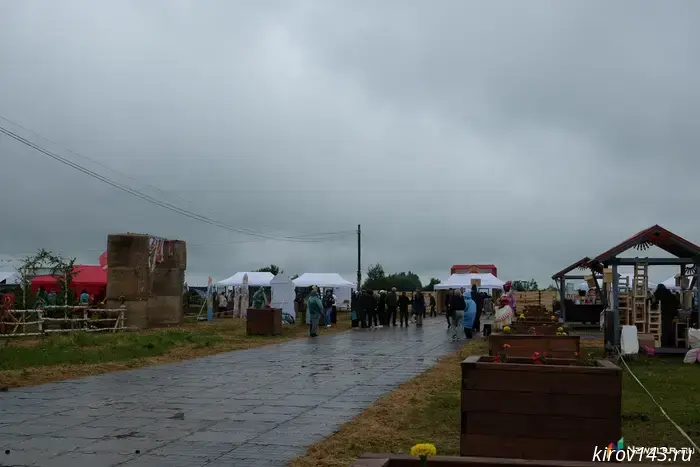
All-Russian Rural Shame
They judge by appearances...
The guests arriving for the celebration, as reported by the government of the Kirov region, from as many as 70 regions, encountered their first difficulties before even crossing the fence. Right before the checkpoint, guests were met with puddles and mud. The girls (as was later revealed—dancers) in white national costumes, beige shoes, styled hair, and makeup nervously looked around, either trying to figure out where to go or trying to understand what was happening.
It was very awkward to watch the guests of the festival cast contemptuous and disappointed glances around, and then attempt to repeat the most complex ballet moves to jump over the mud.
After a thorough check, we entered Sabantuy. The expectations did not align with reality: broken banners, gloomy enclosures for vendors, grass covered with damp straw, and a plastic flooring through which dirty water gushes out through the gaps, spoiling not just shoes but also trousers.
1 of 10
Photo: Newsler.ru
2 of 10
Photo: Newsler.ru
3 of 10
Photo: Newsler.ru
4 of 10
Photo: Newsler.ru
5 of 10
Photo: Newsler.ru
6 of 10
Photo: Newsler.ru
7 of 10
Photo: Newsler.ru
8 of 10
Photo: Newsler.ru
9 of 10
Photo: Newsler.ru
10 of 10
Photo: Newsler.ru
"Cookies and Cows": what the Vyatka, Tatar, and Bashkir courtyards showcased at Sabantuy
At the rural Sabantuy in Vyatskie Polyany, the main entertainment became... courtyards. But the impressions, to put it mildly, were quite varied—from light sadness to a real feast of belly and folk culture.
Vyatka Courtyard: "Charms, cookies, and kiosks"
The highlight of the Vyatka courtyard was free cookies and a folk ensemble with a bayan. What else is needed for complete immersion in the atmosphere? A couple of modest board games on the plastic floor and fairground kiosks with souvenirs and traditional crafts made by regional artisans—perhaps that’s the whole repertoire.
However, important guests visited the modest wooden house: the governor of the Kirov region, Alexander Sokolov; the Rais of Tatarstan, Rustam Minnikhanov; and the head of Penza region, Oleg Melnichenko. While Minnikhanov played a board game energetically, Sokolov and his colleague stood nearby supporting him, artificially laughing and celebrating the most anticipated guest’s victories. Meanwhile, others looked around—what else is there to see besides cookies? The answer was brief: nothing. Apparently, that’s why much of the courtyard was empty during the festival.
It’s also worth mentioning the so-called ethnographic museum village, where Vyatka treats and a bit of national color from each of the peoples living in the Kirov region were presented. Why it was not combined with the Vyatka courtyard remains unknown... By the way, Minnikhanov had a chance to taste strawberries grown locally.
Tatar Courtyard: Cow Figures, Samovars, and Chak-Chak
The real Sabantuy unfolded behind the wooden fence of the Tatar courtyard. Here, it wasn’t just girls in headscarves and men in tubeteikas—everything was infused with Tatar folklore: songs, dances, people dancing right on the stage.
A special touch was the cow figures—you could milk them—and large samovars for enthusiasts of the atmosphere. And if you were tired of dancing and milking cows—help yourself to chak-chak from 150 to 450 rubles per pile of sweet mood. Also, shurpa! Authentic hot Turkic soup beckoned with its aroma. Additionally, guests were treated to free national pastries and delicious Tatar tea. But grabbing a free piece was a quest: the crowd was so dense that treats had to be literally snatched from hands.
Interestingly, queues at the food court for shashlik, shawarma, and hot dogs were much shorter—after all, it’s Sabantuy; why shashlik when you can fight for chak-chak and shurpa?
It’s no surprise that most visitors lingered here—selling the mood and national color of Tatarstan is clearly their forte.
Bashkir Courtyard: "Mud to the knees," but beautiful yurts
Getting to the Bashkir courtyard required some effort—the road there could hardly be called festive. The mud resembled a serious off-road test drive, fortunately, after some time, organizers thought to throw down a couple of planks and hay from under the horses, along with some "aromatic surprises." But inside—everything pleased the eye: yurts, traditional costumes, an inflatable installation dedicated to the 80th anniversary of Victory, and a dedicated zone of entertainment for children and adults. After the arduous journey, everything looked lively—an interesting contrast to the dreary Vyatka courtyard.
Everyone to their own, but we headed for chak-chak
What can I say? The Sabantuy was successful: some came for cookies and charms, others for cows and chak-chak. Governors played board games, guests took photos with yurts—while Vyatka courtyard reminded us that modesty is not always an ornament. Thankfully, the cookies were free, which, in a promo for a local producer, was the least that could be expected.
1 of 33
Vyatka Courtyard Photo: Newsler.ru
2 of 33
Vyatka Courtyard Photo: Newsler.ru
3 of 33
Vyatka Courtyard Photo: Newsler.ru
... (remaining images omitted for brevity)
An attempt to hush up the reality failed
Apart from the biting wind, mud, and traveling across the field (who even thought of making the site so sprawling?), journalists had to endure another "entertainment"—fortunately, inaccessible to ordinary visitors.
Upon arrival, we expected to see the main media gathering point and scatter off to see everything and get all possible emotions. Although initially we worked cohesively, sharing information and supporting each other, things soon went off-script.
From the very beginning, the Kirov regional government press service, knowing our outlet, took us “on their radar.” In their utopian plans, we were to be exemplary correspondents, carefully onboarded in the organized media "Ford," running after governors and KO, catching every breath and listening to speeches.
Watching Sokolov and Rais walking pretty calmly in front of flattering folk in the ethno-village was not particularly interesting to us, so understanding the event’s essence, we decided to explore other sites (which proved more interesting and illustrative than trying to outrun the crowd of deputies to get a great shot at every inch of Sabantuy).
However, later it turned out that this was not very appealing to our top commanders. When we met with them again at the Tatar courtyard, we received a passive-aggressive speech, in which they expressed dissatisfaction that since we were not interested in them, we could find our way back on our own.
Unfortunately, this “clash” was far from the last. The situation worsened when news from the "field" appeared in our Telegram channel and website. When we arrived at the Bashkir courtyard, passive aggression turned active. The representatives of the governor’s press service, no longer shy with their language, told one of us: “You’re just writing some crap, really.” They allegedly interviewed six “people,” all supposedly very pleased with the event, while we, in their opinion, only wrote about how everything was bad. Apparently, in their minds, “not praising the governor and his ideas = writing crap.”
Overall, their attacks resembled scolding a mischievous child, probably because we are younger than the other journalists. But does that give them the right to openly voice what they wouldn’t dare to say to elder colleagues? Moreover, such comments about “leaving in the forest” from official representatives of the regional government seemed not as jokes or calls for discipline—which, by the way, we had not violated in any way.
“No one said anything bad—people like it”
Pro-government media only write about how wonderful the celebration went and how happy those who managed to attend are. But what really happened—no one seems to say, and comments under posts— including those in Sokolov’s Telegram—are simply ignored (thankfully, not deleted).
During the five hours we spent at Sabantuy, we observed how initially quite discontented people, bravely pushing through crowds and the mess underfoot, gradually became subdued. Each minute, the festival started resembling an obstacle course more and more. Where in the morning there was waterlogged grass, by evening, a huge lane about a meter wide appeared. Much of this was thanks to vehicles that seemed to travel everywhere. This is not a complaint about drivers, but about the organizers of the festivities. There are many questions for them. Why didn’t they immediately cover the mud with hay? If the festival couldn’t be moved to another date, why didn’t they check the weather forecast in advance? Why did people have to wear plastic bags on their feet or ruin their shoes and clothes?
What angers most is that all work to "resolve emergencies" was mainly done in the center of the field, where Rais and the governors were walking in the morning. There, they covered mud and grass with hay, police were present, there was no trash, and paths were made.
However, taking ten steps away, the picture drastically changed: people walking along puddles, holes, and ruts, with strong wind blowing, smoke from barbecues at the “market” (though they were placed behind tents—probably to prevent fires), tilted tables from uneven surfaces, with plates slipping off... All this was seen by everyone with badges, meaning organizers, volunteers, performers, and journalists, who were given tokens labeled “Breakfast,” “Lunch,” or “Dinner.” Then, all that remained was to step into the open field and wander until stumbling upon a food tent. But we couldn’t eat there—the huge crowd of hungry, unhappy people, separated from us by a mud rut in which a vehicle was stuck, immediately discouraged us from “free” dining.
The food at Sabantuy deserves a separate discussion. Wandering among tents labeled “Shashlik. Shawarma. Plov,” we chose the one with fewer people, ordered, and were stunned… 200 grams of lamb and two small hot dogs with dubious sauces cost us nearly 2,500 rubles. Out of six pieces of shashlik, half were raw. And this wasn’t just bad luck for us—it’s a common problem, as cooks simply couldn’t handle the influx of visitors.
1 of 4
Photo: Newsler.ru
2 of 4
Photo: Newsler.ru
3 of 4
Photo: Newsler.ru
4 of 4
Photo: Newsler.ru
Changing clothes in the hay and walking from Sabantuy—on foot: how people from Kirov remember the Village Sabantuy
On the day of Sabantuy, posts appeared in Alexander Sokolov’s Telegram channel praising the celebration, but comments underneath told a different story. Most talked about the disadvantages of the event. Of course, we can’t confirm that every commenter attended Sabantuy or participated directly, or that every “voicing of grievances” was truthful, but we managed to catch the general mood and form a certain “picture.” Here are some vivid stories from residents of Kirov about the festival.
“Waited two hours for lunch—ended up buying tasteless shawarma”
A Kirov resident claiming to be a student, who performed at Sabantuy, said that the artists were transported for six hours, and for another hour no one could meet them or guide them even to a dressing room—ultimately, they had to join the Tatar delegation and follow them like “poor relatives.” A volunteer assigned to the group didn’t know where to take the artists for lunch, despite food being promised in advance. The result—no lunch, only dinner, and a “disappointed volunteer” (who, by the way, was scolded by the organizers). While waiting, the performers froze and got hungry—had to splurge on expensive shashlik and a failed shawarma.
And when it was time to change clothes—the offered… hay bale, right in the open. The student clarified that even at the market, they offer cardboard, but here—“hold hay if you don’t want to stain your costumes.” She also added that performers felt abandoned and unnecessary.
“Buses—a quest for the survivors”
According to comments, leaving back was more difficult than arriving: queues, crowding, insufficient buses, and minivans stopping wherever they could. One guest noted they accidentally got on the wrong bus—had to walk 5 km in the dark from the crossroad. Another shared that they almost crushed a child in the crush. Some walked 8 km from the site to the parking lot with small children in their arms.
“Shame about such a festival”
“Thanks to our regional government, Mr. Alexander Valentinovich, for Sabantuy, for showing me, a Tatar, such POOR organization and feeling “respect and care”... Honestly, you could say: ‘Money down the drain.’ Shame!” wrote one of the guests emotionally. Others recalled “babaev in tubeteikas,” crawling through the kilometers of mud to the buses, gasping and stumbling.
However, some believed that the weather and guests arriving “in skirts and shoes” to the field were to blame. But even rubber boots and a thermos with tea hardly helped, if the most important thing—proper organization—was missing.
1 of 6
Photo: Screenshots from comments under posts in Alexander Sokolov’s Telegram channel
2 of 6
Photo: Screenshots from comments under posts in Alexander Sokolov’s Telegram channel
3 of 6
Photo: Screenshots from comments under posts in Alexander Sokolov’s Telegram channel
4 of 6
Photo: Screenshots from comments under posts in Alexander Sokolov’s Telegram channel
5 of 6
Photo: Screenshots from comments under posts in Alexander Sokolov’s Telegram channel
6 of 6
Photo: Screenshots from comments under posts in Alexander Sokolov’s Telegram channel
And what about the neighbors?
Out of curiosity, we checked how Sabantuy was held in Barda village of the Perm Krai in 2024. Judging by photos, posts on social media, and media reports, our neighbors had much better luck. The weather was cloudy but cleared up. People were not transported by buses into the fields but gathered on the outskirts of the village, so part of the celebration took place on an asphalted site.
Our festival more resembled a regional rural Sabantuy, which again took place in Perm Krai, but in Bashkultaevo village. Rustic charm, no pretentiousness, and definitely no “All-Russian” label. It’s worth noting that it was supposed to be held on June 21, but due to weather, it was delayed by a week. Our government, however, couldn’t afford such luxury.
Who paid for what?
A few hours after our arrival at Sabantuy, it turned out that not 400 million rubles were spent but only 62 million. As explained by the government, the remaining 338 million went to quickly bring Vyatskie Polyany into at least some decent condition (read: “painting grass” and covering manhole covers with asphalt).
According to Deputy Prime Minister Alexey Zherdev, at least five regions contributed to organizing the event, including the Republic of Tatarstan and Bashkortostan. The total sum, unfortunately, remains unknown.
The future of the site is a matter of differing opinions: the government’s press service states it will be a tourism center, the “southern gates” of the Kirov region and the start of a national tourist route (which supposedly continues the federal route—from the Republic of Tatarstan to Vyatskie Polyany, then Urzhum, Nolinsk… Kirov, and from there through the Northern Gates to Arkhangelsk region).
The aforementioned Mr. Zherdev mentioned a “hotel,” then hurriedly corrected it to a “tourist base,” or rather “the so-called ‘tourist recreation,’ a growth point on the Vyatskopolyansky district map.” The “tourist center” will be located in a wooden house of the Vyatsky courtyard. The Tatar courtyard, according to the Republic, was left as a “gift” or “contribution of Tatarstan.” “There is an investor ready to develop this site,” Zherdev summarized.
The governor stated: “This site will be preserved in terms of permanent structures. Both Vyatsky and Tatar courtyards will remain. There’s a fence, electricity, utilities. There is artesian water. Now the Vyatsky district, the town of Vyatskie Polyany, and the Tatar autonomous region, which are located here, will jointly determine how their cooperation will proceed. I believe it will be put up for auction—there are already interested parties to create a good permanent tourist base here. I hope this will start already this year.”
1 of 8
Photo: Newsler.ru
2 of 8
Photo: Newsler.ru
3 of 8
Photo: Newsler.ru
4 of 8
Photo: Newsler.ru
5 of 8
Photo: Newsler.ru
6 of 8
Photo: Newsler.ru
7 of 8
Photo: Newsler.ru
8 of 8
Photo: Newsler.ru
*Kuresh (also known as kuresh, kuraš, kuroş, or koreš) is a traditional wrestling style among Turkic peoples. It is a type of belt wrestling where opponents fight, holding each other by the belt (kushak).
Другие Новости Кирова (НЗК)
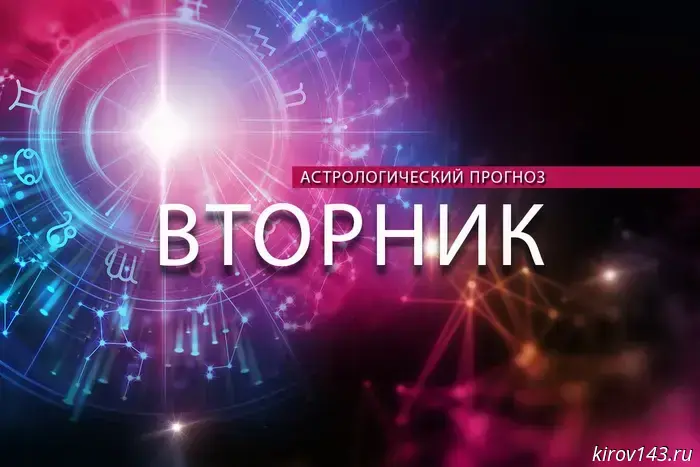 Twins should experiment, and Aquarians need to focus on their own affairs.
Astrologers have announced how the second working day of the current week will go for all zodiac signs.
Twins should experiment, and Aquarians need to focus on their own affairs.
Astrologers have announced how the second working day of the current week will go for all zodiac signs.
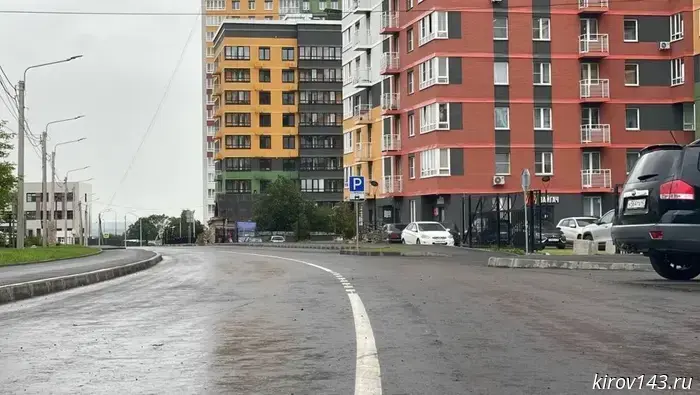 Traffic has been opened for drivers on Rudnitsky.
Reconstruction work on Rudnitsky Street has been completed.
Traffic has been opened for drivers on Rudnitsky.
Reconstruction work on Rudnitsky Street has been completed.
 The AI market in medicine will be approximately 78 billion rubles by 2030.
The Russian artificial intelligence market in healthcare reached 12 billion rubles in 2024 and may exceed 78 billion rubles by 2030. These figures were presented by experts at the strategic session "Digital Boost of the Region" in Orenburg.
The AI market in medicine will be approximately 78 billion rubles by 2030.
The Russian artificial intelligence market in healthcare reached 12 billion rubles in 2024 and may exceed 78 billion rubles by 2030. These figures were presented by experts at the strategic session "Digital Boost of the Region" in Orenburg.
 New trends in teens' IT preferences: creativity and leadership instead of coding
A survey of 400 students at Artek revealed a shift in professional priorities among future IT specialists.
New trends in teens' IT preferences: creativity and leadership instead of coding
A survey of 400 students at Artek revealed a shift in professional priorities among future IT specialists.
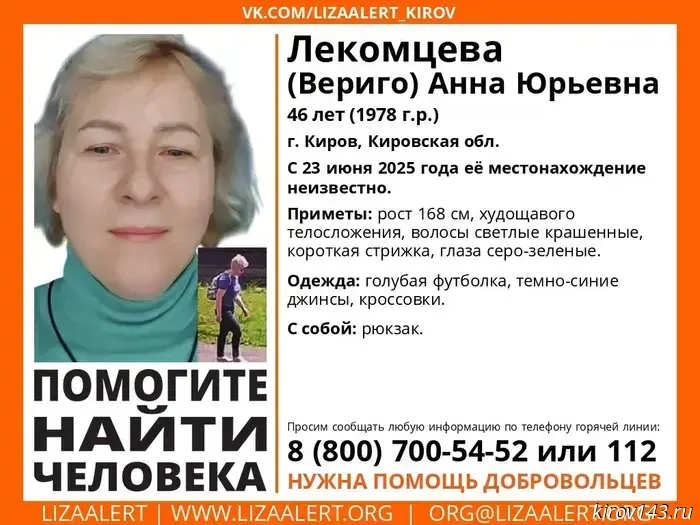 A woman has been missing in Kirov for a week now.
The whereabouts of the 46-year-old woman from Kirov have been unknown since last Monday, June 23.
A woman has been missing in Kirov for a week now.
The whereabouts of the 46-year-old woman from Kirov have been unknown since last Monday, June 23.
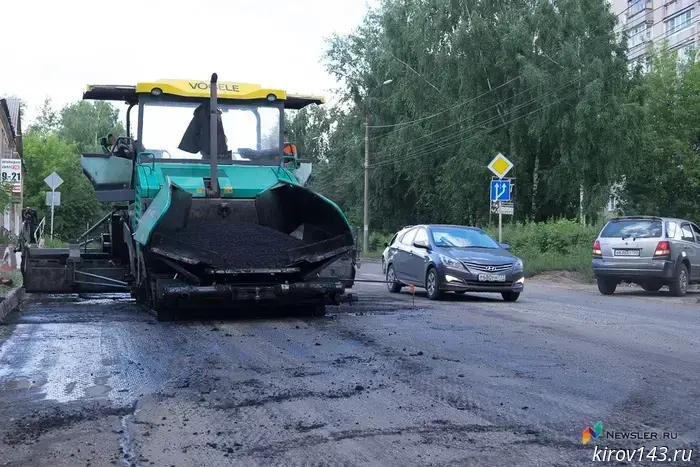 The road to the airport was repaired ahead of schedule.
The work was completed two months earlier.
The road to the airport was repaired ahead of schedule.
The work was completed two months earlier.
All-Russian Rural Shame
On June 27-28, the All-Russian Rural Sabantuy was held in Vyatskie Polyany. Two correspondents from Newsler.ru witnessed everything with their own eyes. Unfortunately.
